Many businesses rely on outbound calls to engage potential customers, but without accurate tracking, it becomes challenging to identify which conversations contributed to measurable outcomes. Sales teams and call center agents may handle hundreds of calls, but without a reliable system in place, connecting those calls back to specific ads, keywords, or client campaigns remains a challenge.
Choosing the right outbound call tracking software addresses this problem by helping track calls, record conversations, score leads, and monitor performance. Teams can review call analytics, monitor conversation quality, and tag outcomes using tools such as call scripting and scoring.
The most effective platforms combine fair pricing, responsive customer support, and experience in addressing both basic and complex tracking needs. These tools often include features such as call queues, lead scoring, AI-powered call transcription, and CRM system integrations, designed to help businesses improve conversion rate across their outbound call campaigns.
This guide compares the top 10 outbound call tracking software tools for 2025, highlighting their key features and strengths. Each platform is evaluated for how it supports marketing ROI, improves customer service, and contributes to stronger pipeline engagement, starting with a provider trusted by teams that prioritize clarity, control, and measurable outcomes.
List of Top 10 Outbound Call Tracking Software
- AvidTrak
- Aircall
- CallRail
- CallTrackingMetrics
- CloudTalk
- JustCall
- RingCentral Contact Center
- Ringover
- Squaretalk
- WhatConverts
1. AvidTrak
 Many businesses begin with basic tools to track outbound calls, but those tools often fall short as campaign complexity increases. Without the ability to monitor lead quality, manage call queues, or attribute performance to specific marketing tactics, teams lose clarity on what is working.
Many businesses begin with basic tools to track outbound calls, but those tools often fall short as campaign complexity increases. Without the ability to monitor lead quality, manage call queues, or attribute performance to specific marketing tactics, teams lose clarity on what is working.
AvidTrak offers a practical solution for this problem. As an affordable and flexible outbound call tracking software, AvidTrak supports detailed attribution, call routing, and agent-level call performance tracking. The platform is trusted by sales teams, call centers, and agencies that require reliable call tracking without added complexity.
With 14 years of domain expertise, transparent pricing, and responsive product support, AvidTrak helps teams stay in control of their call campaigns while reducing wasted ad spend.
Features
- AI-powered Call Transcription with keyword flagging
- Sentiment analysis
- After Hours Call Routing
- Tracking ID Hide/Display
- IVR (Interactive Voice Response)
- Area Code-Based Call Routing
- Simultaneous Call Forwarding
- Sequential Call Forwarding
- Sub-domain Number Follow
- Call Email Alerts
- Email Marketing
- Call Recording
- Caller sentiment capability
- Advanced DNI Options
- Call Whisper
- Third-Party Integrations
- Form Tracking
- Google Analytics 4 Integration
- Inventory of Phone Numbers
- Customizable Call Attribution
- Customizable Reporting Dashboard
Top 3 Features
1. AI-Powered Call Transcription and Tagging
 AvidTrak transcribes every outbound conversation and tags keywords to identify lead intent. Call transcription improves visibility into caller interest, agent performance, sales pitch weaknesses, and customer responses, providing more informed campaign management decisions and improving the quality of follow-ups.
AvidTrak transcribes every outbound conversation and tags keywords to identify lead intent. Call transcription improves visibility into caller interest, agent performance, sales pitch weaknesses, and customer responses, providing more informed campaign management decisions and improving the quality of follow-ups.
2. CRM and Ad Platform Integrations
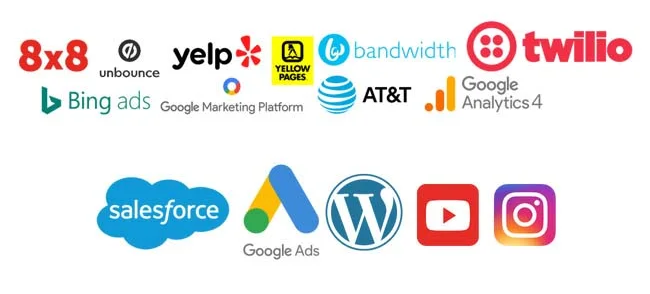 AvidTrak connects call activity directly with CRM systems and ad platforms, such as Google Ads and GA4, helping teams align call activity with campaign spend, evaluate marketing ROI, and segment leads across multiple client campaigns.
AvidTrak connects call activity directly with CRM systems and ad platforms, such as Google Ads and GA4, helping teams align call activity with campaign spend, evaluate marketing ROI, and segment leads across multiple client campaigns.
3. Outbound Dialing with Call Outcome Tracking
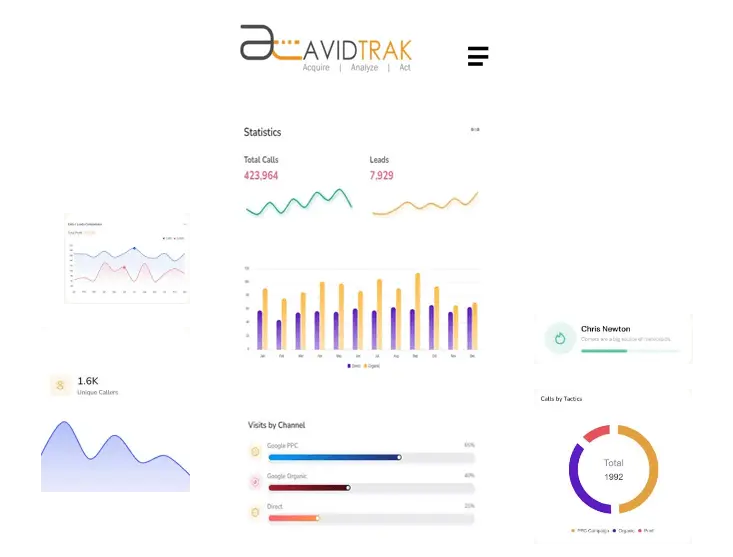 AvidTrak allows users to place outbound calls from tracked numbers while tagging conversations based on lead quality or interest level, helping sales teams and remote agents track conversion rates, improve follow-ups, support lead generation, and avoid re-engaging low-priority contacts.
AvidTrak allows users to place outbound calls from tracked numbers while tagging conversations based on lead quality or interest level, helping sales teams and remote agents track conversion rates, improve follow-ups, support lead generation, and avoid re-engaging low-priority contacts.
Pros
- Excellent customer support and instant response times
- Transparent, affordable pricing with no hidden fees
- No obligation 14-day free trial with $20 credit, inclusive of all features
- Feature rich low-cost tracking, recording, AI transcription, and marketing attribution
- Easy setup and user-friendly interface
- Extensive customization options without any additional charges
- Optimize campaigns to increase conversions
- Seamless integration with CRM platforms
Cons
- No GHL integration
Pricing
AvidTrak offers 3 pricing plans mentioned below:
- Starter: $15/month
- Professional: $30/month
- Agency: $55/month
Final Verdict
AvidTrak is designed for teams that demand precision in every outbound call. With features such as AI-powered transcription, agent-level tracking, outcome tagging, and campaign attribution, AvidTrak equips teams to act on performance data, not assumptions.
Businesses that prioritize affordability, control, and service, AvidTrak remains one of the few outbound call tracking software platforms built to handle both simple and complex needs, without added cost or clutter.
2. Aircall
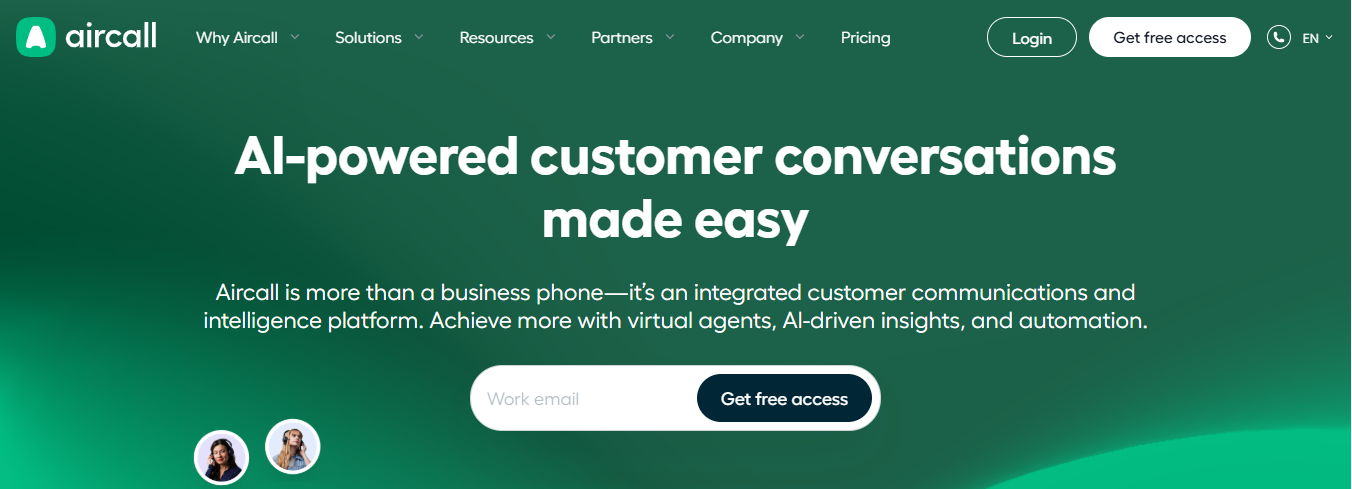 Aircall positions itself as a phone and communication platform for support and sales teams, with a focus on usability and basic integration support. The platform includes call tracking and tagging for outbound calls, along with a clean interface for managing call center agents and small team collaboration.
Aircall positions itself as a phone and communication platform for support and sales teams, with a focus on usability and basic integration support. The platform includes call tracking and tagging for outbound calls, along with a clean interface for managing call center agents and small team collaboration.
While Aircall offers lightweight tools for outbound call tracking software, it is built more for simplicity than control. It handles essential functions such as call recording, call queues, and CRM integrations. Still, it lacks deeper visibility into conversation analytics, call outcome tagging, or campaign-level performance tracking found in more specialized systems.
Features
- Outbound and inbound call management
- Call tagging
- Call recording
- Call queue management
- Basic analytics and activity dashboard
- IVR setup and internal directories
- Team-Based Call Assignment
- Integrations with help desk and CRM tools
Top 3 Features
1. Team-Based Call Assignment
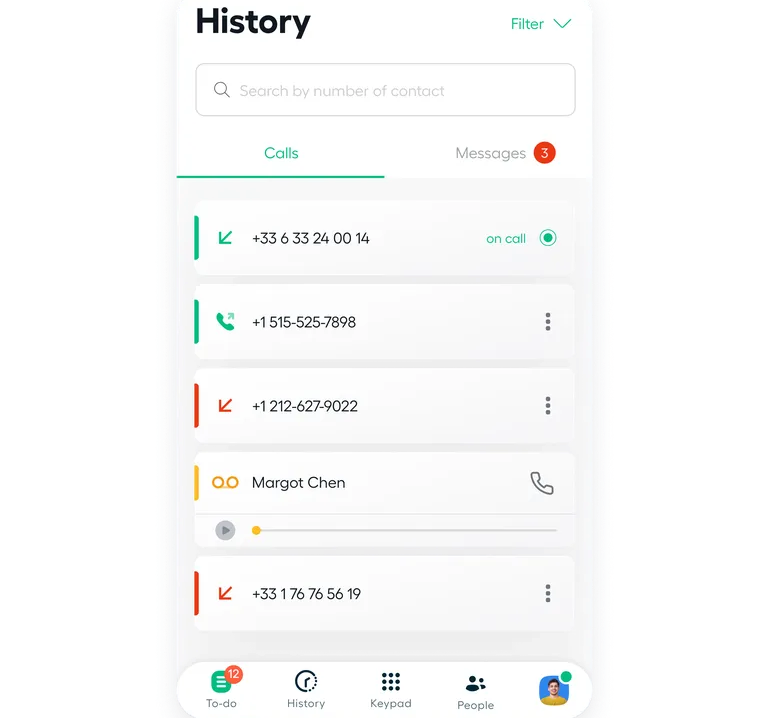 Aircall supports shared call inboxes and internal tagging, making it easier for small teams to manage outgoing call lists and assign follow-ups across multiple agents.
Aircall supports shared call inboxes and internal tagging, making it easier for small teams to manage outgoing call lists and assign follow-ups across multiple agents.
2. Basic Analytics Dashboard
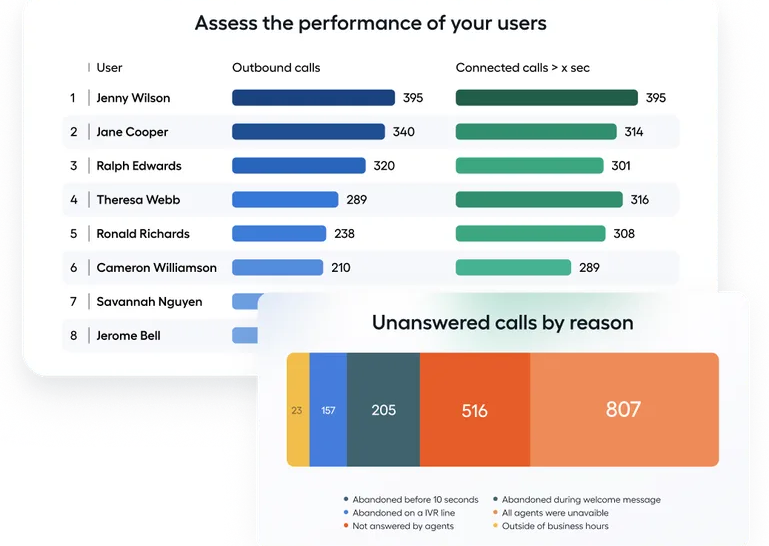 Users can track overall call activity, agent availability, and average call duration. However, the data is limited to surface metrics and does not support outcome-specific tracking or detailed conversion reporting.
Users can track overall call activity, agent availability, and average call duration. However, the data is limited to surface metrics and does not support outcome-specific tracking or detailed conversion reporting.
3. IVR and Directory Setup
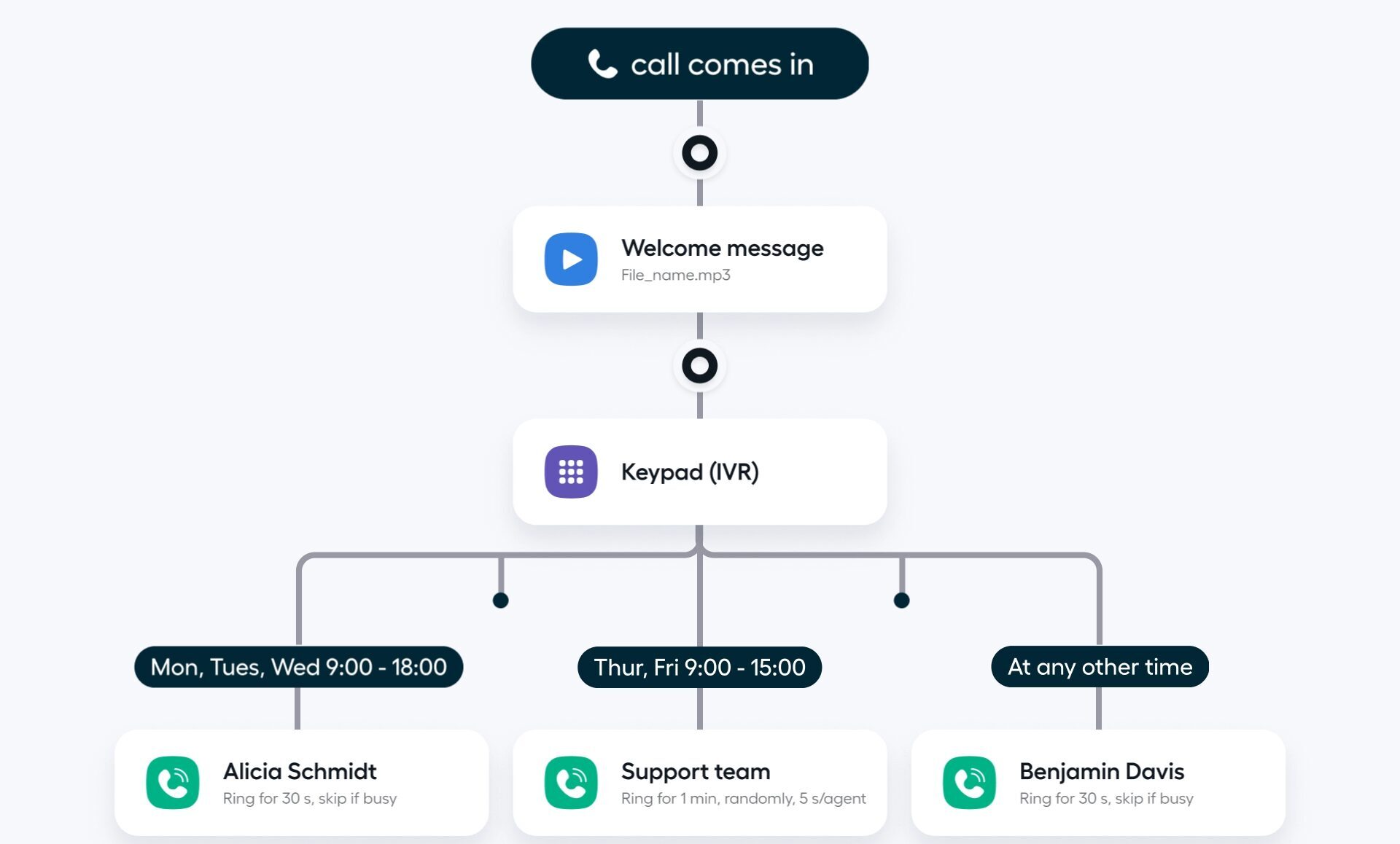 The IVR feature allows businesses to set up menus and direct outbound or returned calls to internal departments. Routing options are fixed and do not support conditions such as zip code filters or time-based routing.
The IVR feature allows businesses to set up menus and direct outbound or returned calls to internal departments. Routing options are fixed and do not support conditions such as zip code filters or time-based routing.
Pros
- Clean interface
- Easy setup
- CRM integrations
- Shared inboxes
Cons
- Weak support for large teams
- Usage-based pricing model
- No campaign-level attribution
- Limited routing rules
- Not built for complex tracking
Pricing
AirCall offers 2 pricing plans:
- Essentials: $40/license monthly, $30/license annually
- Professionals: $70/license monthly, $50/license annually
Final Verdict
Aircall offers a simple experience for small teams managing basic outbound calling tasks. However, businesses seeking complete control over attribution, routing, or conversation analytics will quickly encounter limitations.
The platform lacks support for AI-powered transcription, lead scoring, or detailed call outcome reporting, which are essential for evaluating conversion rate and improving marketing ROI from outbound calls. While Aircall may be easy to launch, it is not suited for performance-driven teams managing complex outbound call tracking software needs.
3. CallRail
 CallRail markets itself as a call tracking and analytics tool primarily for marketers and agencies. The platform supports basic outbound call tracking software needs through features such as call recording, tagging, and campaign-level source tracking. Most of its value lies in centralizing call activity into one dashboard and connecting it with marketing campaigns.
CallRail markets itself as a call tracking and analytics tool primarily for marketers and agencies. The platform supports basic outbound call tracking software needs through features such as call recording, tagging, and campaign-level source tracking. Most of its value lies in centralizing call activity into one dashboard and connecting it with marketing campaigns.
However, teams handling high-volume call campaigns or complex routing workflows may find the platform limited in execution. While features such as call queues, call analytics, and CRM systems integrations are available, the platform leans more toward marketing visibility than operational control.
Features
- Outbound and inbound call tracking
- Keyword-level attribution
- Call recording and transcription
- Call tagging
- Call queues
- Source-level call reporting
- Basic lead scoring
- Custom call flows
- CRM and ad platform integrations
Top 3 Features
1. Keyword-Level Tracking
CallRail assigns phone numbers to keywords, allowing teams to view which search terms result in calls. This helps tie ad spend to call volume, though visibility stops short of full conversion rate analysis or call outcome logging.
2. Custom Call Flows
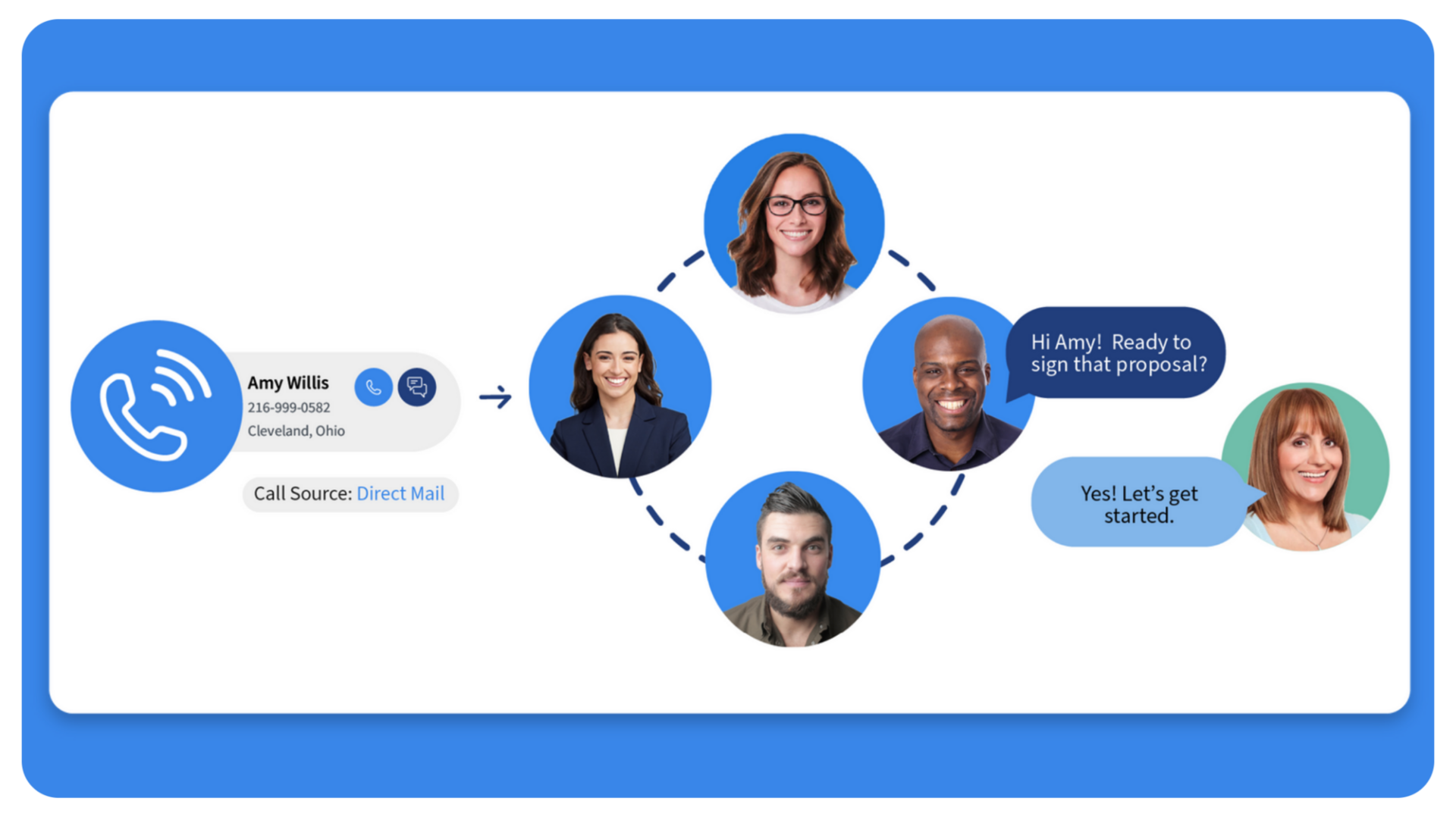 Users can build introductory call flows with branching logic to control call routing. While the visual tool is useful, routing remains limited to basic conditions without deeper options such as zip code or area-based routing.
Users can build introductory call flows with branching logic to control call routing. While the visual tool is useful, routing remains limited to basic conditions without deeper options such as zip code or area-based routing.
3. Call Tags and Basic Lead Scoring
 CallRail allows users to tag calls and assign basic lead scores. However, scoring is manual, and there is no native AI-powered transcription to automate outcome-based tagging or support conversation analytics.
CallRail allows users to tag calls and assign basic lead scores. However, scoring is manual, and there is no native AI-powered transcription to automate outcome-based tagging or support conversation analytics.
Pros
- Easy-to-navigate dashboard
- Basic campaign attribution
- Works with common CRM platforms
- Simple UI
Cons
- Weak support for remote teams
- Additional usage fees
- Limited reporting customization
- Lacks agent-level controls
Pricing
CallRail offers the following pricing plans:
- Call Tracking: $45/month
- Call Tracking + Conversation Intelligence: $90/month
- Call Tracking + Form Tracking: $90/month
- Call Tracking Complete: $135/month
Final Verdict
CallRail is designed for marketers who focus on lead source tracking, but it may not meet the operational needs of outbound teams managing real-time call center activity.
The platform lacks support for agent scorecards, user presence detection, or conversation quality tools that help optimize outbound performance. While it covers surface-level attribution, the absence of AI transcription, call outcome reporting, and deeper routing control limits its ability to serve as a full-scale outbound call tracking software solution for performance-driven teams.
4. CallTrackingMetrics
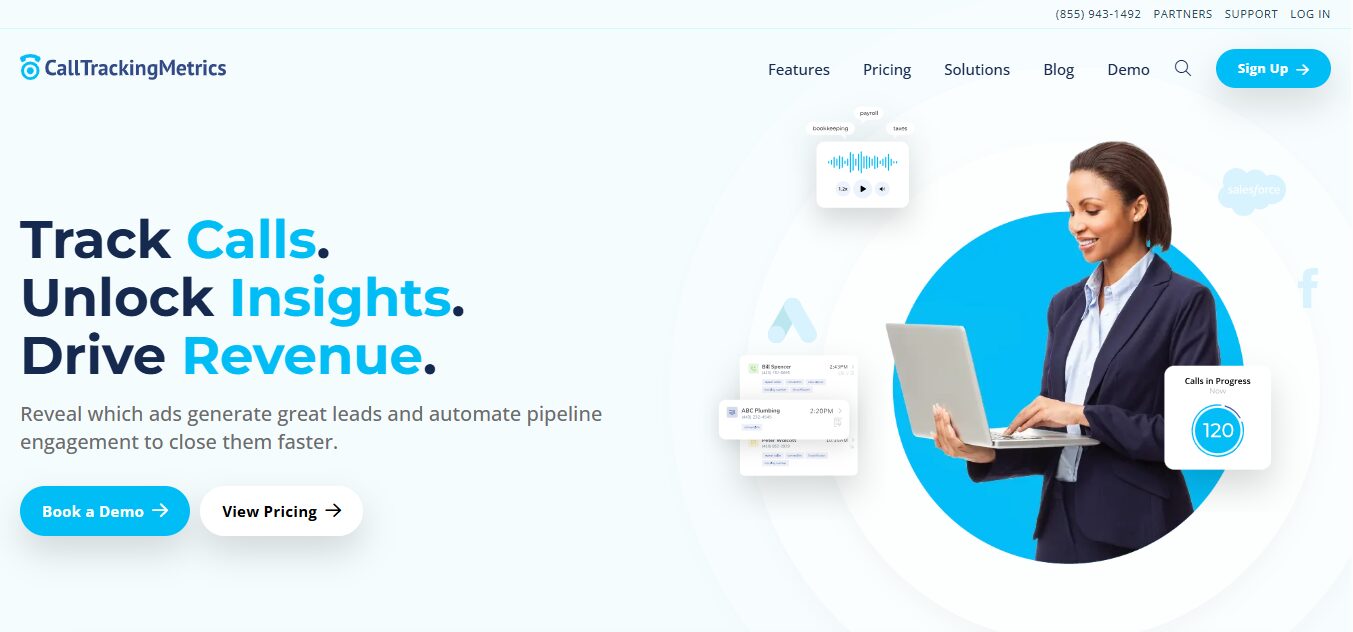 CallTrackingMetrics provides a unified platform for call tracking and contact center management, primarily used by marketing teams and service-based businesses. The platform features outbound call tracking software capabilities, allowing users to record outbound calls, assign tags, and link activity to advertising campaigns.
CallTrackingMetrics provides a unified platform for call tracking and contact center management, primarily used by marketing teams and service-based businesses. The platform features outbound call tracking software capabilities, allowing users to record outbound calls, assign tags, and link activity to advertising campaigns.
The tool offers a range of features for call center agents and sales teams, with many of its tools specifically designed for mid-sized operations. While it covers essential needs such as call queues, lead scoring, and basic conversation analytics, there are limitations around pricing flexibility, self-service setup, and outbound tracking control.
Features
- Call tracking and call recording
- Call tags
- Custom call routing
- CRM integrations
- Form tracking
- Conversation keyword spotting
- Lead scoring tools
- Management dashboard
- Automated follow‑up reminders
Top 3 Features
1. Call Recording
 Teams can review outbound calls through audio recordings. While helpful for checking call quality, there is no AI-powered transcription or automation tied to conversation outcomes.
Teams can review outbound calls through audio recordings. While helpful for checking call quality, there is no AI-powered transcription or automation tied to conversation outcomes.
2. Automated Follow-Up Reminders
 The system can send follow-up alerts based on predefined triggers. Although helpful for basic re-engagement, it lacks deeper automation tied to conversation quality, conversion rate, or lead behavior analysis.
The system can send follow-up alerts based on predefined triggers. Although helpful for basic re-engagement, it lacks deeper automation tied to conversation quality, conversion rate, or lead behavior analysis.
3. SMS and Call-Based Nurture Sequences
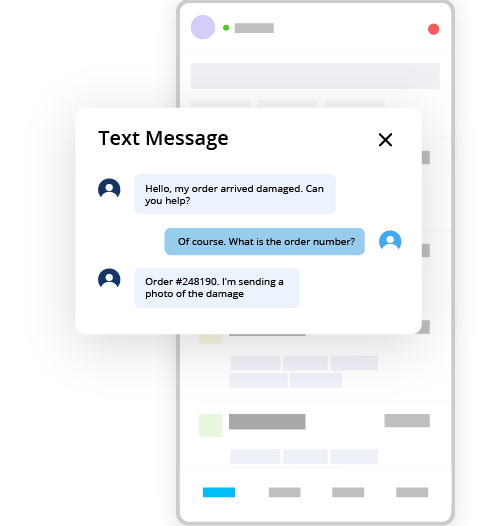 Drip campaigns can be built using outbound calls and SMS to recontact leads over time. However, this process depends heavily on preset rules and does not incorporate dynamic conditions such as intent-based tagging, AI-powered transcription, or multi-step lead scoring.
Drip campaigns can be built using outbound calls and SMS to recontact leads over time. However, this process depends heavily on preset rules and does not incorporate dynamic conditions such as intent-based tagging, AI-powered transcription, or multi-step lead scoring.
Pros
- Basic tools for outbound follow-up
- Works well for structured teams
- Simple lead status tracking
- Integrates with major CRMs
Cons
- Interface feels complex
- Pricing rises with usage
- Not optimized for agile outbound campaigns
- No outcome-based tagging
- Setup may require help
Pricing
CallTrackingMetrics offers the following plans:
- Marketing Lite: $79/month billed yearly
- Marketing Pro: $179/month billed yearly
- Sales Engage: $329/month billed yearly
- Enterprise: $1999/month billed yearly
Final Verdict
CallTrackingMetrics delivers functional tools for marketing teams that need pipeline engagement tracking and outbound call workflows. However, the absence of AI-powered transcription, agent scorecards, or granular call outcome tracking makes it less suitable for performance-driven teams that require full visibility into conversion rate and campaign attribution.
5. CloudTalk
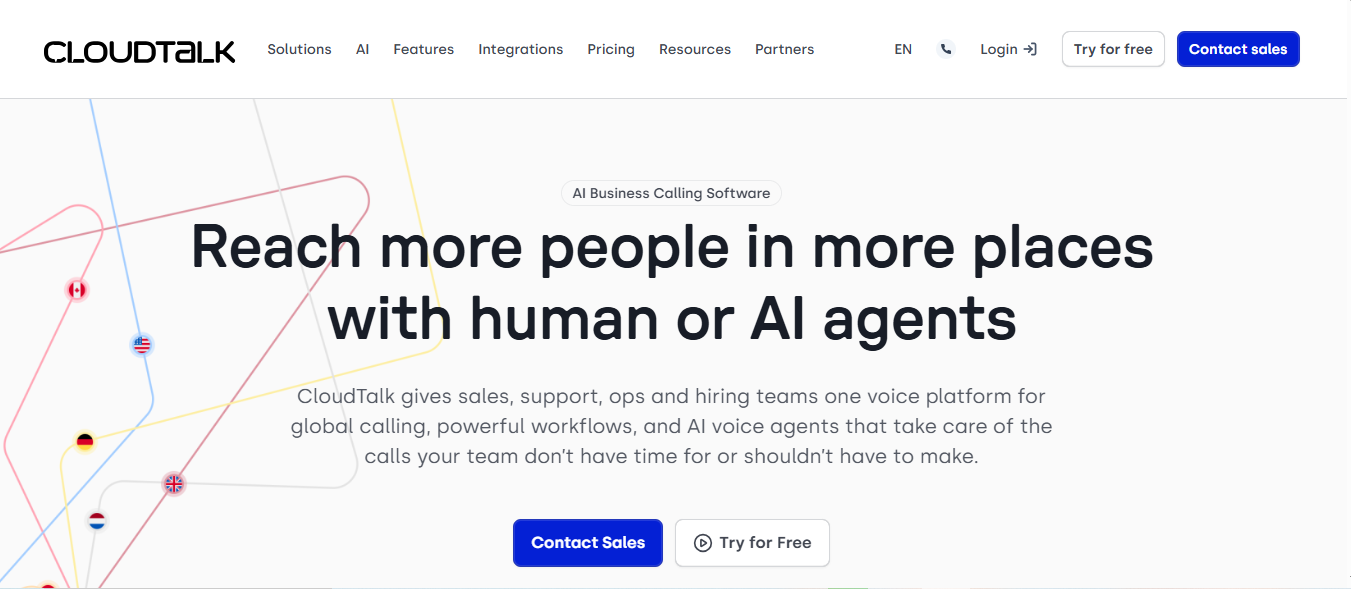 CloudTalk is a VoIP-based phone system designed for customer support and inside sales teams. It includes outbound call tools, basic automation, and call tracking tied to internal activity. For businesses running multiple call campaigns, CloudTalk offers click-to-call functionality, call recording, and routing options based on business hours or agent groups.
CloudTalk is a VoIP-based phone system designed for customer support and inside sales teams. It includes outbound call tools, basic automation, and call tracking tied to internal activity. For businesses running multiple call campaigns, CloudTalk offers click-to-call functionality, call recording, and routing options based on business hours or agent groups.
While the platform works well for small to mid-sized teams, it lacks detailed attribution, conversation analytics, and campaign-level tracking. The tool is more focused on internal collaboration and call center setup than on outbound performance.
Features
- Outbound and inbound calling
- Call queuing
- Call recording
- Call tagging and shared inbox
- CRM integrations
- Call tags and notes
- Business hours routing
- Manual call notes
- IVR setup
- Internal team messaging
Top 3 Features
1. Call Tagging
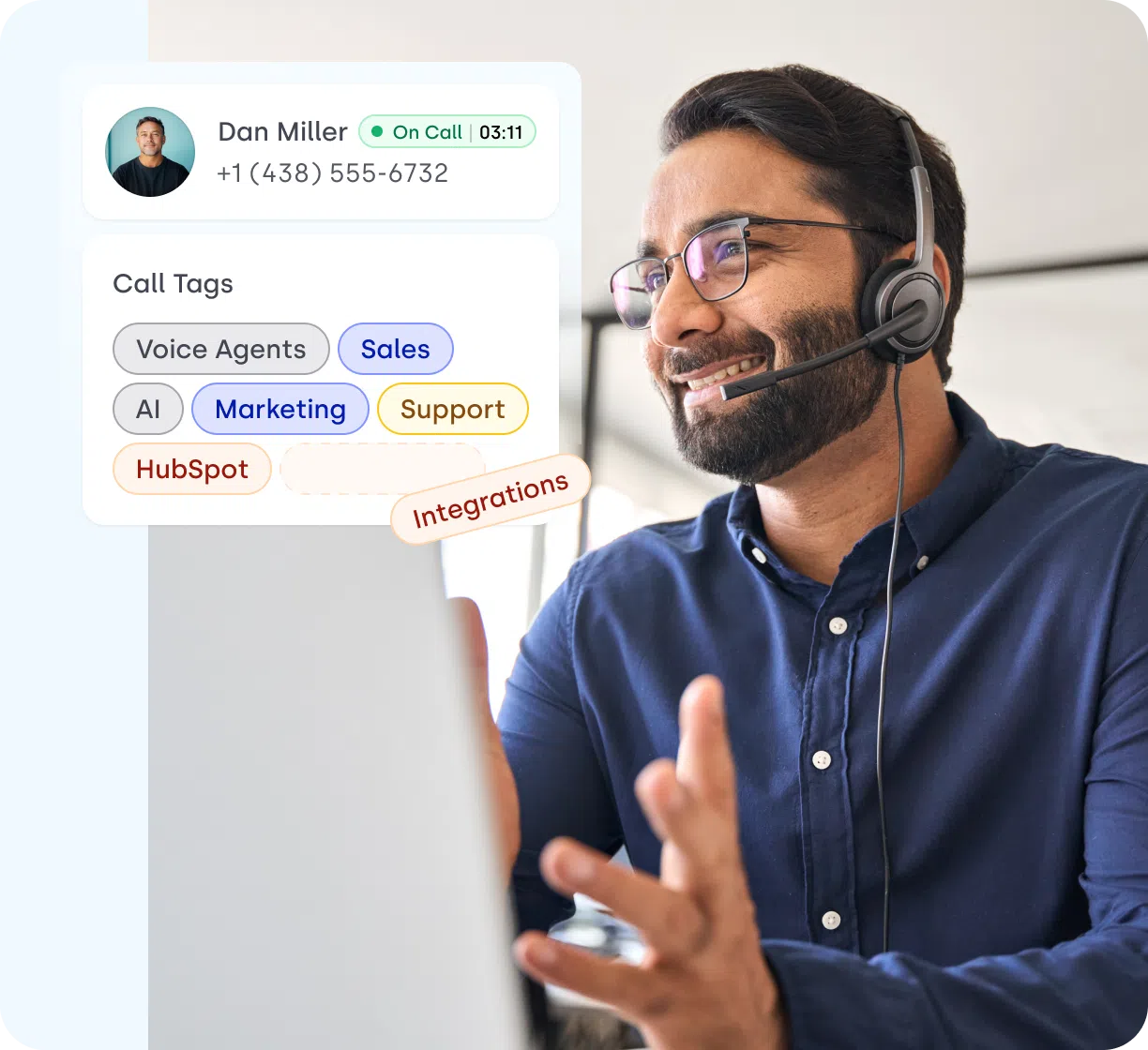 CloudTalk allows team members to manage outbound calls through a shared inbox with tagging for organization. However, tags are basic and not linked to conversion or lead quality outcomes.
CloudTalk allows team members to manage outbound calls through a shared inbox with tagging for organization. However, tags are basic and not linked to conversion or lead quality outcomes.
2. Manual Call Notes
 CloudTalk allows agents to leave notes after outbound calls and assign follow-ups to teammates. This helps with handoffs but does not include call scripting, AI assistance, or structured conversation analysis.
CloudTalk allows agents to leave notes after outbound calls and assign follow-ups to teammates. This helps with handoffs but does not include call scripting, AI assistance, or structured conversation analysis.
3. Click-to-Call
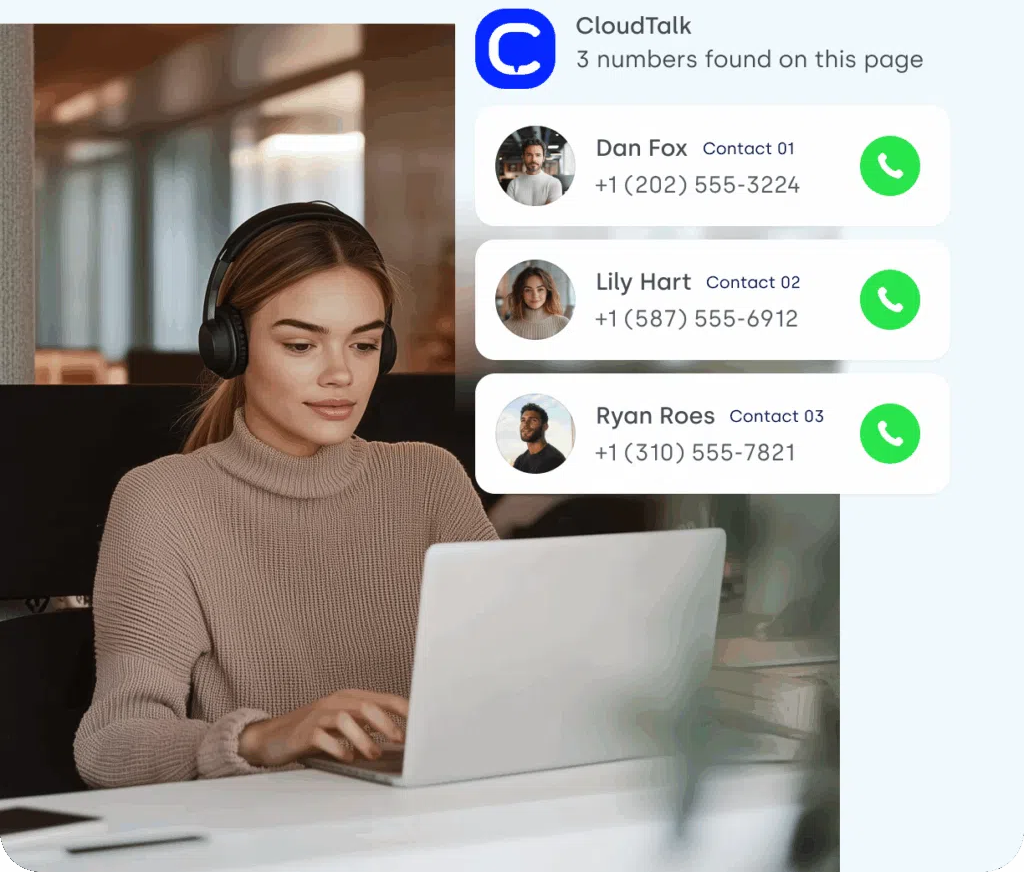 Agents can dial out from integrated platforms or the app using the click-to-call feature. While efficient, there’s no built-in lead scoring, outcome tagging, or detailed call analytics tied to outbound activity.
Agents can dial out from integrated platforms or the app using the click-to-call feature. While efficient, there’s no built-in lead scoring, outcome tagging, or detailed call analytics tied to outbound activity.
Pros
- Easy call tagging
- CRM integrations
- User-friendly dashboard
- Internal team chat
Cons
- Doesn’t include campaign-level tracking
- Lacks conversion metrics
- No outbound lead scoring
- Limited call outcome logging
- Additional charges for extra features
Pricing
CloudTalk offers the following pricing plans:
- Starter: $25/month
- Essential: $30/month
- Expert: $50/month
- Custom: Contact sales
Final Verdict
CloudTalk is a suitable option for small teams that require outbound call support with basic functionality. However, it lacks deeper visibility into conversion rate, call outcomes, or performance-based lead generation.
Tools such as AI-powered transcription, agent scorecards, or flexible campaign routing are not included, which limits its value for teams looking to track and improve marketing ROI through outbound calling.
6. JustCall
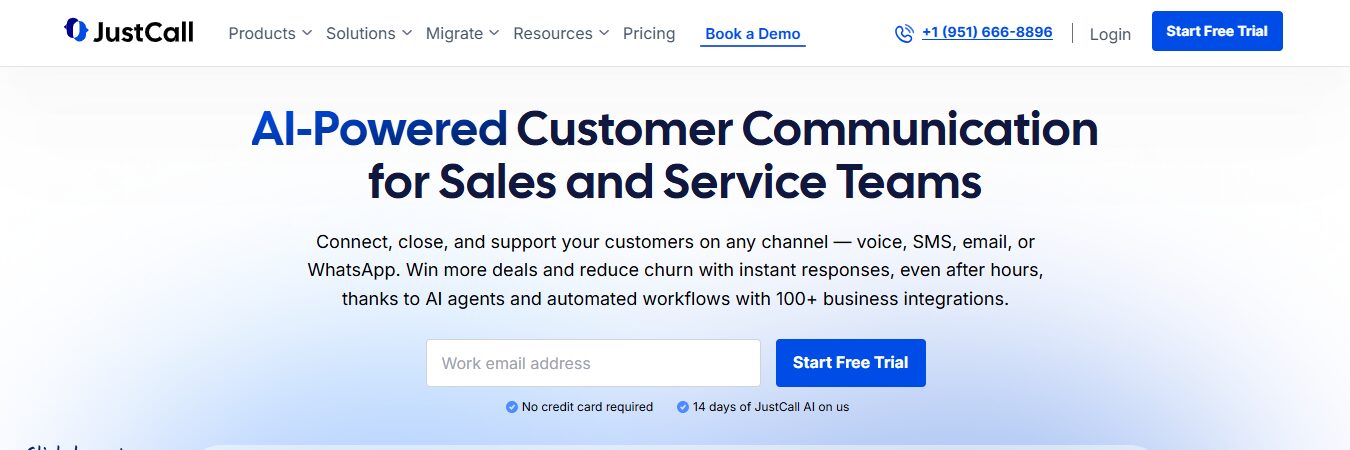 JustCall focuses on productivity-first dialing for remote and inside sales teams. It positions itself as a simple outbound call tracking software with auto dialers, click-to-call tools, and CRM syncing. While it does offer basic tracking and task logging, the platform leans more toward high-volume outreach workflows than deep call attribution.
JustCall focuses on productivity-first dialing for remote and inside sales teams. It positions itself as a simple outbound call tracking software with auto dialers, click-to-call tools, and CRM syncing. While it does offer basic tracking and task logging, the platform leans more toward high-volume outreach workflows than deep call attribution.
Sales teams looking to run faster outbound contact center software operations will find JustCall helpful for quick execution. However, for businesses needing structured lead qualification, conversion rate analysis, or outcome tagging, its visibility into call results remains limited.
Features
- Click-to-call browser extension
- Call logging and notes
- Outbound and inbound calling
- Call recording
- Call queueing
- Auto dialer
- CRM and help desk integrations
- Workflow automation
Top 3 Features
1. Auto Dialer
 JustCall allows agents to dial from call lists and log tasks within CRMs. While efficient for outreach, it lacks tagging for call outcomes or lead quality segmentation.
JustCall allows agents to dial from call lists and log tasks within CRMs. While efficient for outreach, it lacks tagging for call outcomes or lead quality segmentation.
2. Click-to-Call Extension
Users can dial outbound numbers directly from websites or CRMs. This improves speed but offers no conversation analytics, smart routing, or real-time agent tracking.
3. Notes and Reminders
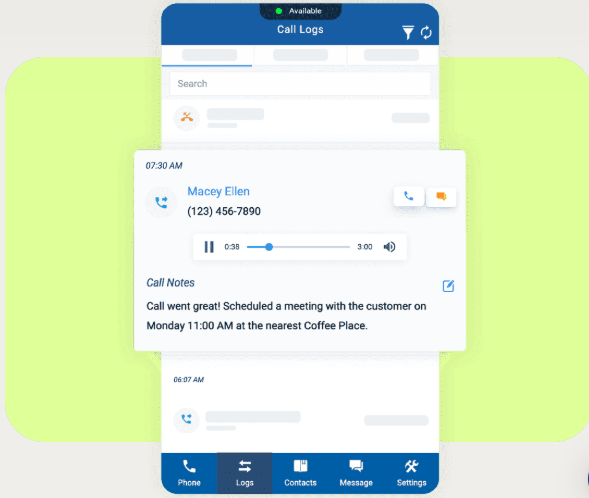
Agents can log outbound interactions with notes and create follow-up reminders. However, there’s no built-in scoring, AI transcription, or performance-based workflow logic.
Pros
- Easy for sales reps to adopt
- Fast setup with minimal training
- Simplifies repetitive outbound tasks
- Lightweight for small or remote teams
Cons
- Outcome tagging is not supported
- No built-in lead scoring for outbound
- Limited call tracking beyond CRM logs
- Workflow builder lacks attribution logic
- No performance metrics per campaign
Pricing
JustCall offers the following pricing plans:
- Team: $29 per user/month, billed annually
- Pro: $49 per user/month, billed annually
- Pro Plus: $89 per user/month, billed annually
- Business: Custom
Final Verdict
JustCall is designed to help teams move quickly through call lists and automate routine dialing tasks. While it functions well for outreach-heavy teams, it lacks the tracking precision expected from the best outbound call center software. Without features such as AI-powered transcription, advanced call outcome logging, or campaign-linked attribution, teams focused on detailed performance data may need more depth than JustCall provides.
7. RingCentral
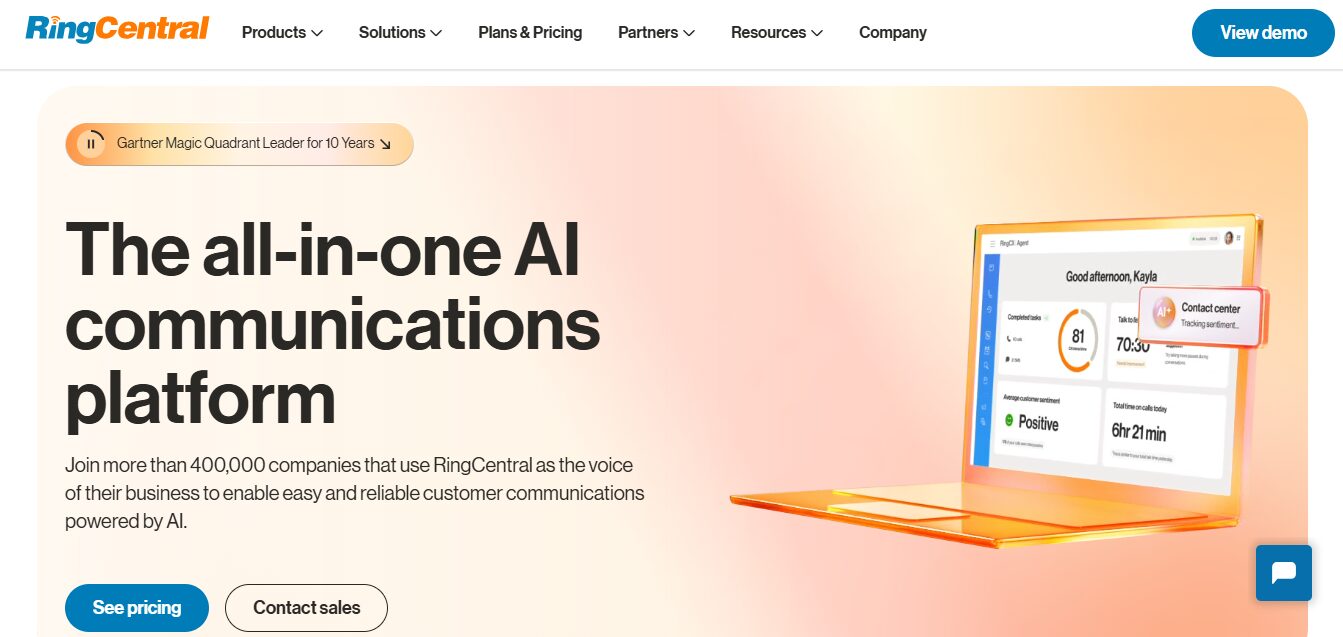 RingCentral is designed to support general call center operations, offering voice, chat, and video capabilities. It supports outbound call tracking software functions such as call queues, dialing options, and activity logging, primarily for teams handling routine contact center tasks.
RingCentral is designed to support general call center operations, offering voice, chat, and video capabilities. It supports outbound call tracking software functions such as call queues, dialing options, and activity logging, primarily for teams handling routine contact center tasks.
While RingCentral offers a wide range of communication options, its outbound tracking capabilities are limited in terms of tagging, campaign-level attribution, and scoring based on conversation quality. Teams focused on evaluating conversion rate or managing structured call campaigns may require more specialized tracking options.
Features
- Outbound calling tools
- Call queueing and IVR menus
- Standard call recording
- CRM integrations
- Callback scheduling
- Basic analytics dashboard
- Messaging and chat tools
Top 3 Features
1. Call Queues
 Agents can be added to outbound queues, and calls can be routed based on availability. However, there is no campaign-based routing or real-time performance scoring.
Agents can be added to outbound queues, and calls can be routed based on availability. However, there is no campaign-based routing or real-time performance scoring.
2. Callback Scheduling
Sales teams can set callbacks for outbound leads and log outcomes such as missed, connected, or follow-up needed. But the system lacks automated tagging or conversion tracking.
3. Basic Dashboards
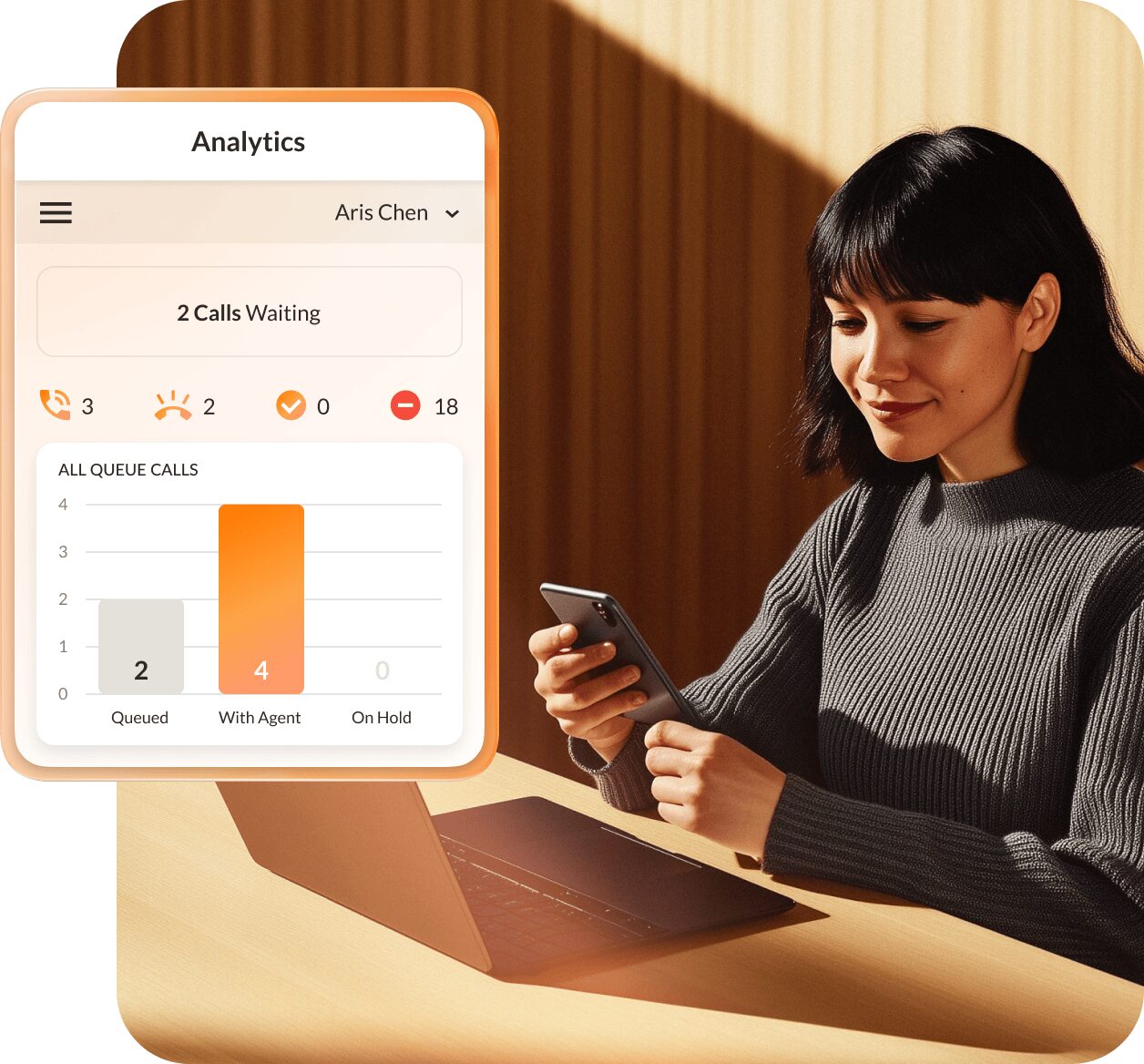 Supervisors can track call durations, volumes, and statuses from a centralized dashboard. However, there are no tools for transcription or analyzing customer responses for quality or sentiment.
Supervisors can track call durations, volumes, and statuses from a centralized dashboard. However, there are no tools for transcription or analyzing customer responses for quality or sentiment.
Pros
- Familiar with IT and telecom teams
- Built-in scheduling and queue support
- Easily connects with existing CRM systems
- Suitable for general contact center environments
Cons
- Not optimized for marketing or sales teams
- Limited outbound attribution tools
- Pricing rises quickly with feature upgrades
- Dashboard lacks granular breakdowns
- Voice analytics unavailable
Pricing
RingCentral offers 3 pricing plans:
- Core: $20/user per month
- Advanced: $25/user per month
- Ultra: $35/user per month
Final Verdict
RingCentral suits large teams managing blended communication channels. While it handles outbound calls within general call center operations, it lacks the structured tracking, tagging, and conversion rate visibility that are essential for marketing or sales-driven teams. It suits basic outbound needs, but for advanced outbound call tracking software requirements, teams will likely need a more specialized solution.
8. Ringover
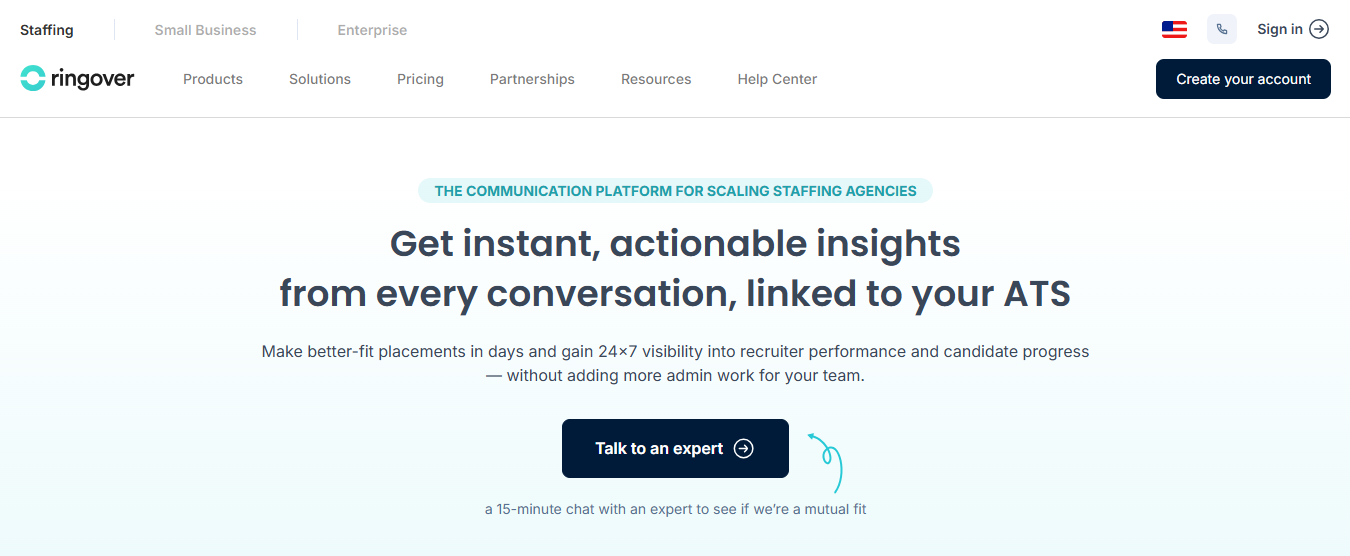 Ringover is a business phone system that includes basic outbound call tracking software functions for sales teams and small support desks. The platform supports browser-based calling, call logging, and CRM integration, but is not designed for detailed pipeline engagement, agent-level performance tracking, or outcome-based attribution.
Ringover is a business phone system that includes basic outbound call tracking software functions for sales teams and small support desks. The platform supports browser-based calling, call logging, and CRM integration, but is not designed for detailed pipeline engagement, agent-level performance tracking, or outcome-based attribution.
While it suits routine outreach, teams that require structured lead qualification, conversation analytics, or AI-powered transcription will likely need more than what Ringover provides.
Features
- Outbound and inbound calling
- Power dialer
- Call notes and tags
- Basic analytics dashboard
- Call recording
- CRM and helpdesk integration
- Local and toll-free numbers
- SMS functionality
Top 3 Features
1. Power Dialer & Outbound Campaigns
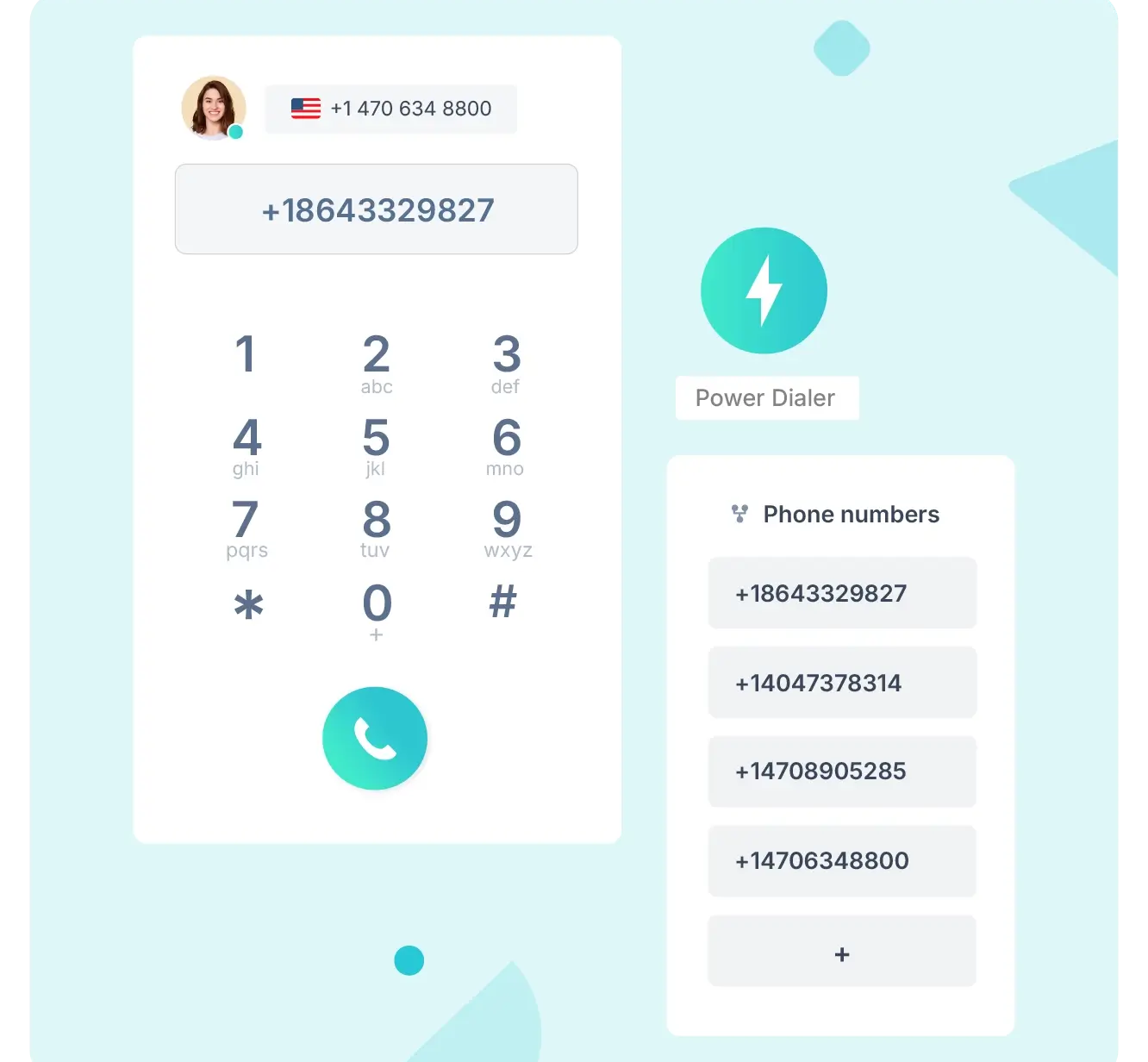 Ringover lets users run call campaigns with a power dialer, voicemail drop, and local presence dialing. Campaign-level tracking is available, but it lacks outcome-based automations and campaign-based attribution with granular reporting.
Ringover lets users run call campaigns with a power dialer, voicemail drop, and local presence dialing. Campaign-level tracking is available, but it lacks outcome-based automations and campaign-based attribution with granular reporting.
2. CRM-Synced Call Recording and Basic Tags
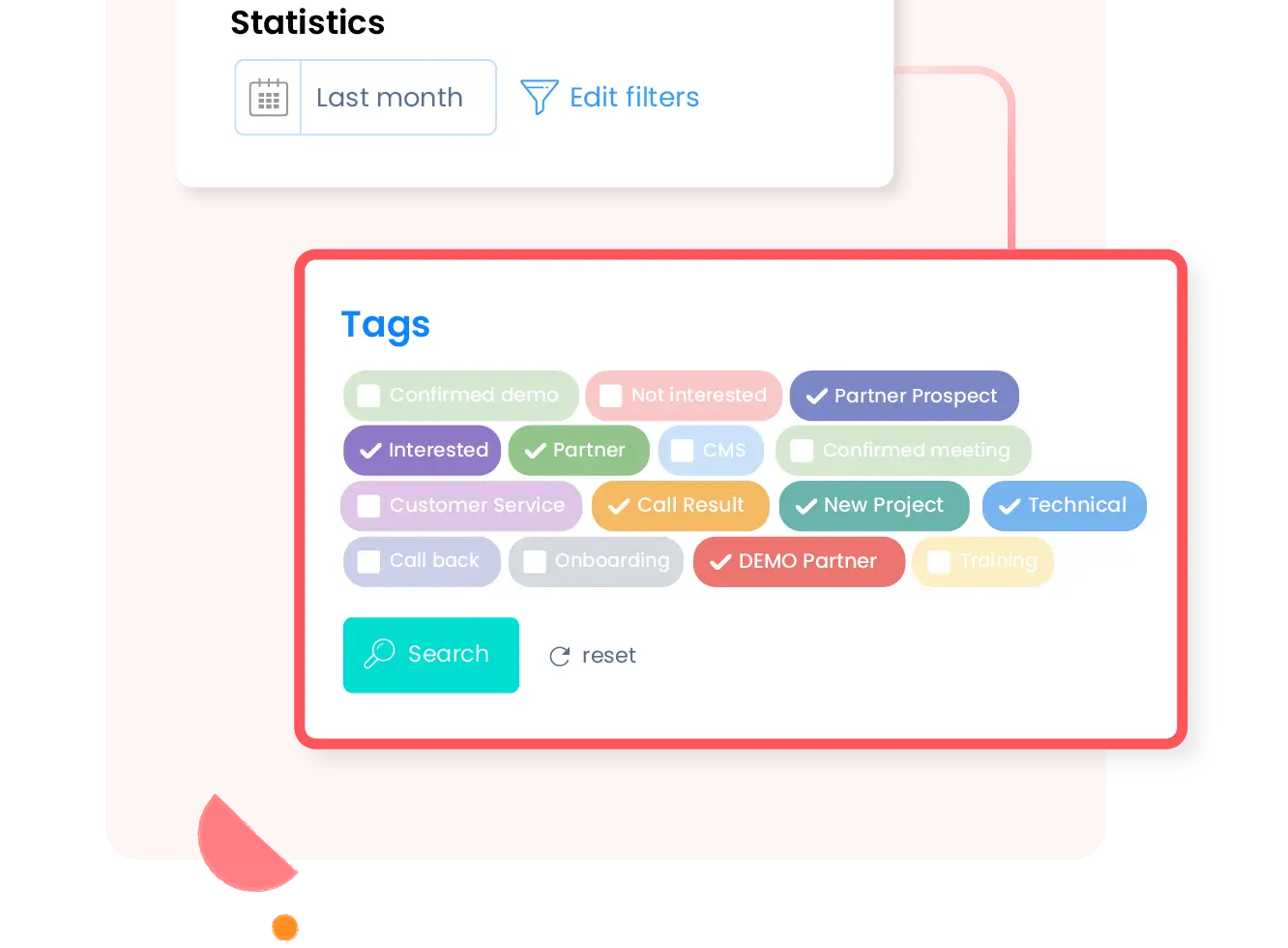 Outbound call activity is logged directly into connected CRMs. Users can manually add tags and notes, but the system lacks automatic lead quality scoring.
Outbound call activity is logged directly into connected CRMs. Users can manually add tags and notes, but the system lacks automatic lead quality scoring.
3. Real-Time Activity Dashboard
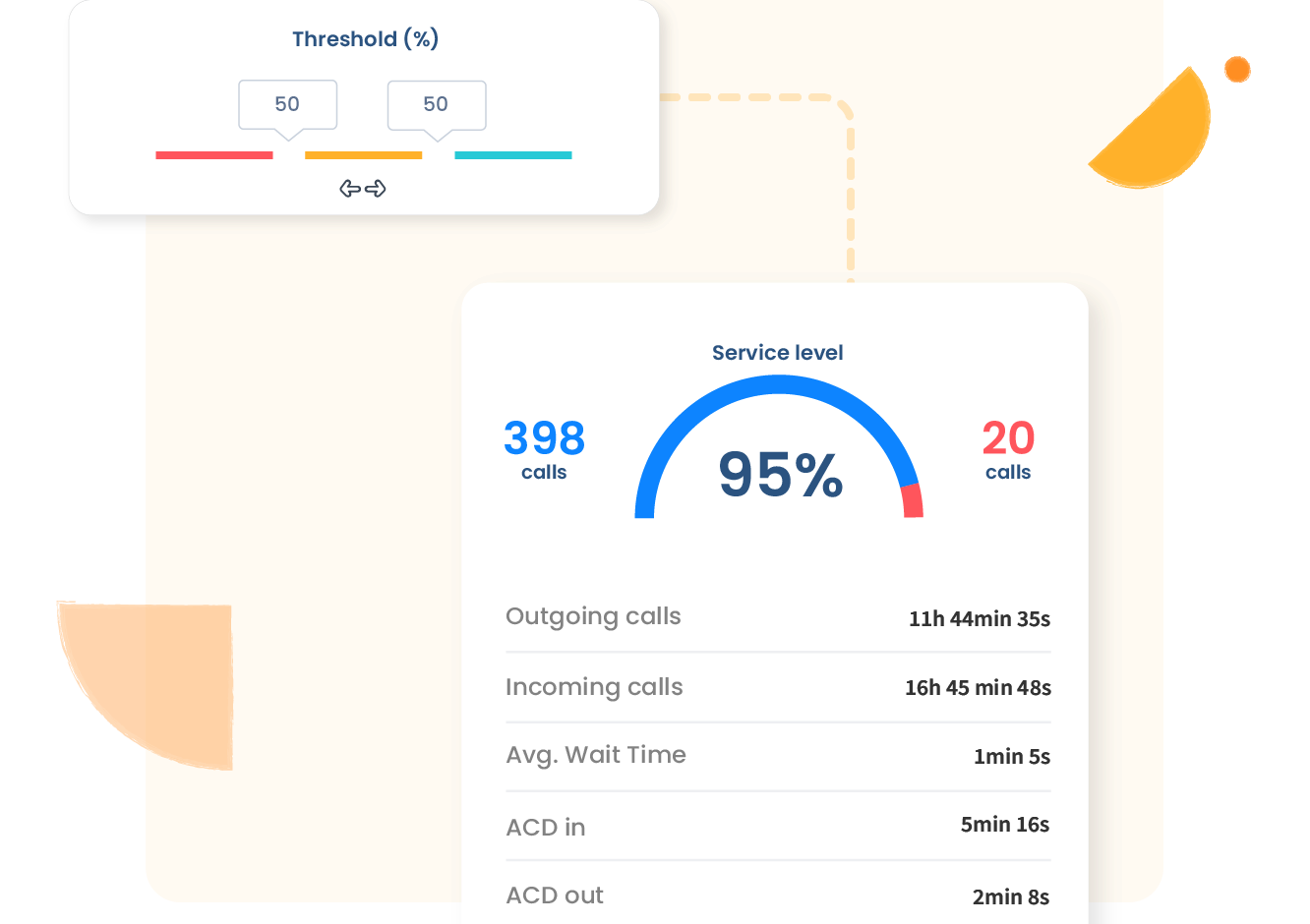 Ringover provides a dashboard that shows live outgoing call volumes, agent statuses, and queue metrics. It does not include deeper conversion rate tracking, sentiment analytics, or AI-based keyword tagging that support structured outbound performance measurement.
Ringover provides a dashboard that shows live outgoing call volumes, agent statuses, and queue metrics. It does not include deeper conversion rate tracking, sentiment analytics, or AI-based keyword tagging that support structured outbound performance measurement.
Pros
- Easy CRM dialing setup
- Works without physical phone hardware
- Clean UI for small teams
Cons
- No lead scoring tools for outbound
- Manual tracking of follow-ups
- Basic analytics not tied to campaigns
- Pricing increases with user count
Pricing
Ringover offers 3 pricing options:
- Smart: $21/User/month
- Business: $44/User/month
- Advanced: Customized
Final Verdict
Ringover works for teams that rely on basic outbound calling tools and simple workflows. However, the platform does not support call analytics, lead scoring, or tagging based on conversation quality, which limits its use for teams that care about conversion tracking or understanding the results of their call campaigns. It may suit short sales cycles, but not outbound operations that require detailed performance tracking or tailored response routing.
9. Squaretalk
 Squaretalk is a cloud-based contact center platform with outbound call tracking features suited to teams handling high outreach volumes. It offers predictive dialing, campaign workflows, and real-time logs tied to call activity.
Squaretalk is a cloud-based contact center platform with outbound call tracking features suited to teams handling high outreach volumes. It offers predictive dialing, campaign workflows, and real-time logs tied to call activity.
While Squaretalk includes valuable tools like call recording, CRM sync, and performance dashboards, many of its automation and analytics features extend beyond simple outbound dialing, making the platform appear advanced in areas not necessary for basic tracked outbound workflows.
Features
- Power dialing
- Call recording and playback
- Campaign-based outbound workflows
- Real-time call activity dashboard
- Manual tagging and call notes
- CRM integrations
- Queue management
- Basic IVR routing
- Local number assignment
Top 3 Features
1. Power Dialer
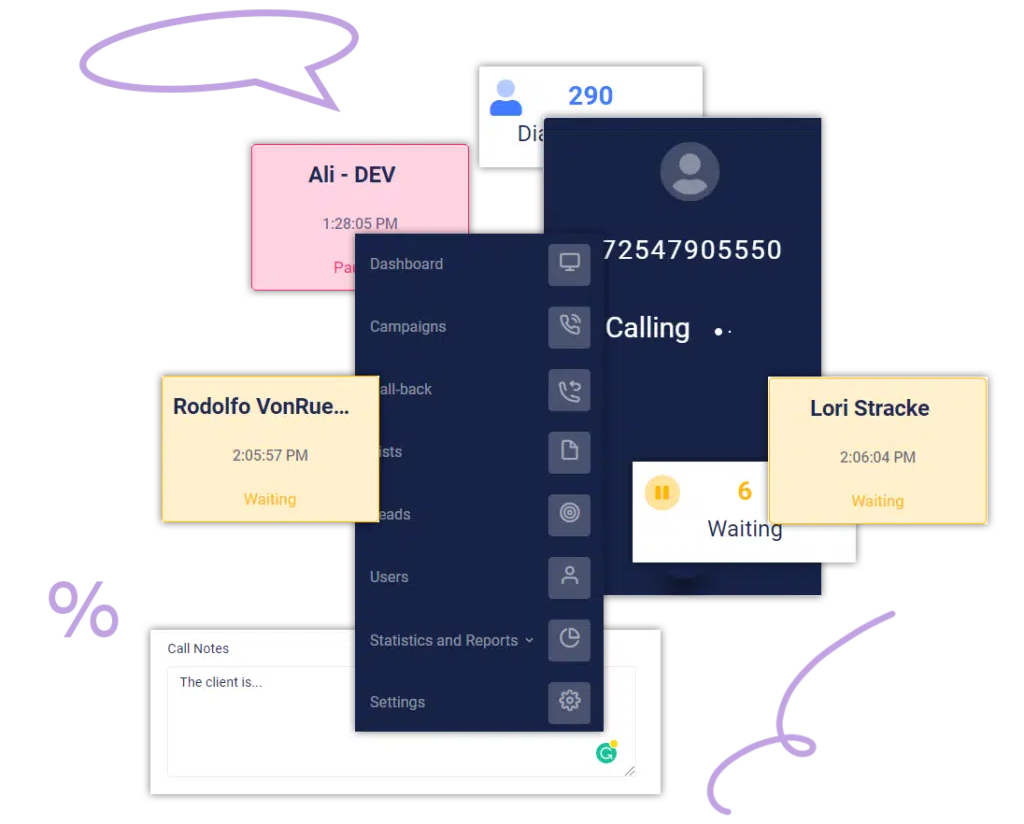 Squaretalk supports predictive or power dialing tied to campaign workflows for outbound outreach.
Squaretalk supports predictive or power dialing tied to campaign workflows for outbound outreach.
2. Real-Time Call Activity Dashboard
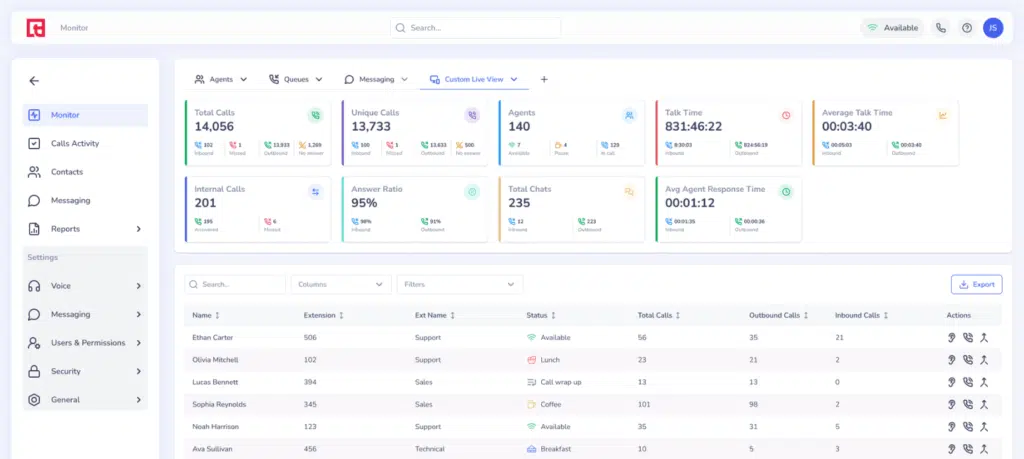 Supervisors can monitor outbound volume, agent statuses, and call queues live. There’s minimal focus on conversion tracking or campaign-linked reporting beyond aggregated metrics.
Supervisors can monitor outbound volume, agent statuses, and call queues live. There’s minimal focus on conversion tracking or campaign-linked reporting beyond aggregated metrics.
3. Call Recording with Manual Annotations
Calls can be recorded and notes added manually post-call, but there is no built-in AI transcription, automatic tagging, or scoring driven by conversation context or sentiments.
Pros
- Scales easily for recurring outbound campaigns
- Simple platform integration with CRMs
- Real-time visibility into call flow
Cons
- Outcome tagging must be performed manually
- No intent or sentiment analytics
- Basic reporting metrics per agent
- High-tier feature set required for full dialing capacity
- No call scripting for dynamic agent prompts
Pricing
Squaretalk offers a tiered pricing plan:
- Core: $25 monthly contract
- Connect:$40 monthly contract
- Scale: Contact the team
Final Verdict
Squaretalk works well for companies that want to organize calling schedules and monitor outbound activity at a basic level. However, the platform does not provide detailed tagging, advanced reporting, or transcription tools to understand what happens during each call. This may limit its value for teams that depend on accurate tracking of sales conversations, follow-up actions, or caller intent across campaigns.
10. WhatConverts
 WhatConverts is designed for tracking leads across calls, forms, and chats, making it a suitable choice for inbound-focused marketers. While it offers call tracking, source attribution, and reporting tools, its outbound call tracking software capabilities are minimal.
WhatConverts is designed for tracking leads across calls, forms, and chats, making it a suitable choice for inbound-focused marketers. While it offers call tracking, source attribution, and reporting tools, its outbound call tracking software capabilities are minimal.
There are no built-in features for tagging calls by outcome, reviewing agent-level activity, or managing follow-up sequences across call campaigns. For sales teams and agencies prioritizing outbound performance tracking and conversation quality, the platform may lack the depth required to support full-funnel outbound operations.
Features
- Dynamic Number Insertion for calls and forms
- Inbound call recording and basic tagging
- Lead tracking
- Marketing channel attribution
- Dashboard and reports
- White label agency tools
- Lead qualification workflows
- CRM and ad platform integrations
Top 3 Features
1. Tracking Numbers
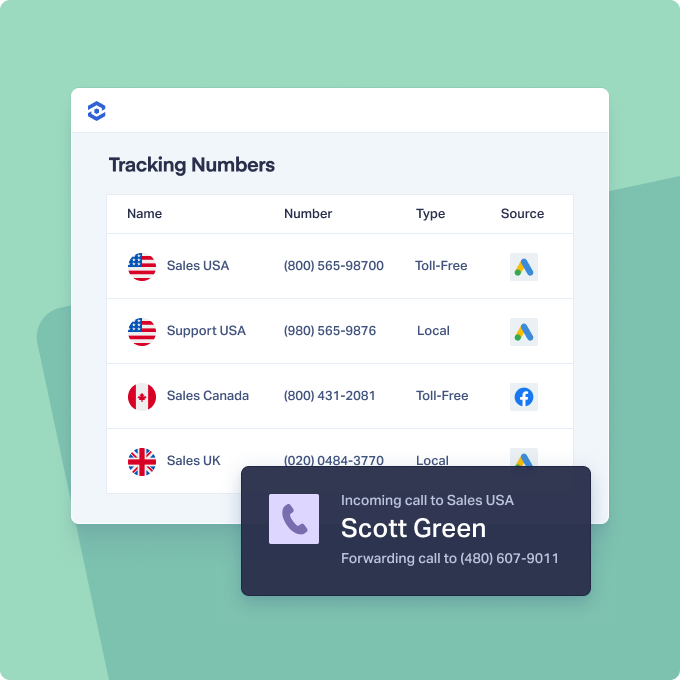 The platform assigns tracked numbers based on visitor source, enabling inbound call attribution back to specific ad or keyword campaigns. This is suitable for inbound attribution but does not extend to outbound call campaign tracking.
The platform assigns tracked numbers based on visitor source, enabling inbound call attribution back to specific ad or keyword campaigns. This is suitable for inbound attribution but does not extend to outbound call campaign tracking.
2. Lead Management
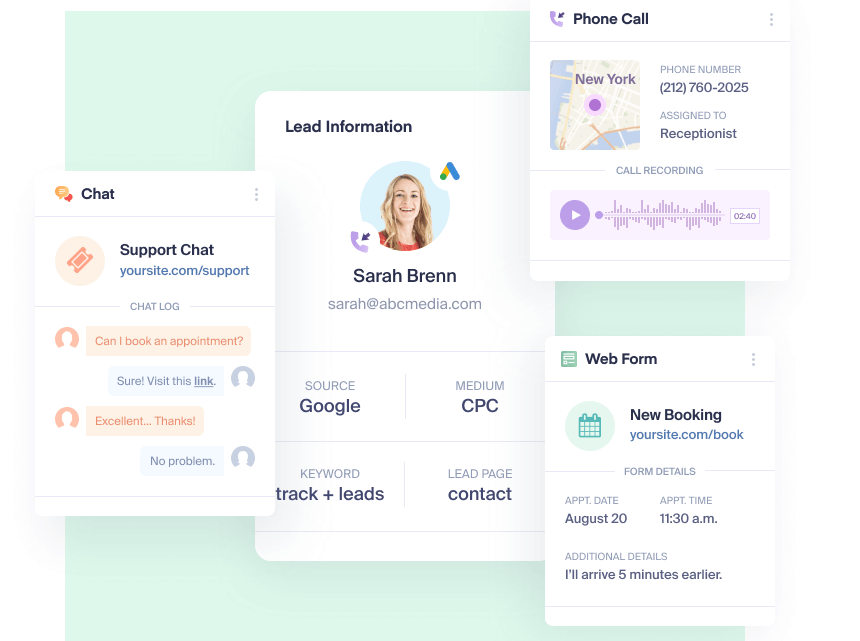 Users can view calls, form submissions, chat interactions, and sales transactions in one dashboard. But this does not include agent-level outbound call scoring or performance insights.
Users can view calls, form submissions, chat interactions, and sales transactions in one dashboard. But this does not include agent-level outbound call scoring or performance insights.
3. Custom Reporting
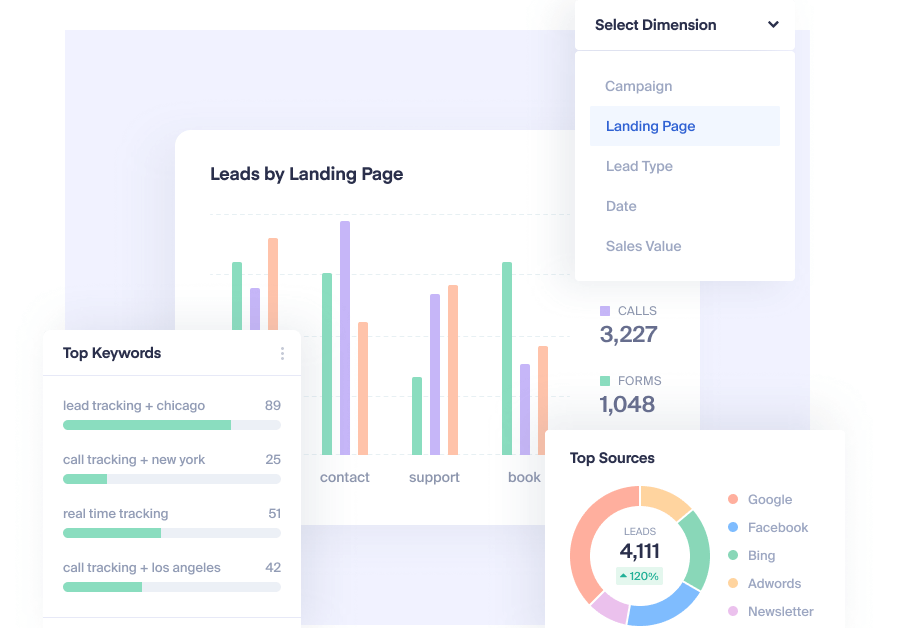 Reports can be built around lead counts, conversion value by channel, or campaign performance over time. Detailed outbound call analysis, such as follow-up success or voicemail response correlation, is not supported.
Reports can be built around lead counts, conversion value by channel, or campaign performance over time. Detailed outbound call analysis, such as follow-up success or voicemail response correlation, is not supported.
Pros
- Easy to set up and start tracking inbound campaigns
- Includes tracking across calls, forms, and chats
- Simple attribution reports by campaign or keyword
- White label option for marketing agency reporting
Cons
- Limited outbound campaign features
- No AI-powered transcription tools
- No tagging based on call quality or intent
- Doesn’t track outbound conversion success
- No automated call outcome workflows
Pricing
WhatConverts offers four pricing plans:
- Call Tracking: $30/month
- Plus: $60/month
- Pro: $100/month
- Elite: $160/month
Final Verdict
WhatConverts works well for inbound marketers, but teams managing outbound call campaigns may find its capabilities limited. There are no tools for qualifying outbound leads, no tagging based on conversation quality, and no performance data tied to outbound follow-up. As a result, businesses needing deeper outbound visibility may prefer a more balanced solution.
Conclusion
A business that depends on outbound call tracking software needs more than just a dialer or a basic tracking feature. It requires a platform that offers reliable performance, real visibility into call campaigns, and the ability to support both simple and advanced tracking challenges, without creating extra work or inflated costs.
AvidTrak leads with a practical approach to outbound call tracking. With more than 14 years of experience, strong customer support, and competitive pricing, AvidTrak offers a reliable solution for businesses focused on conversion rate, lead quality, and accurate attribution.
AvidTrak includes tools such as AI-powered transcription, call scripting, agent scorecards, and campaign-level tracking, giving teams full control over outbound performance and measurable outcomes.
For sales teams and agencies that demand full visibility, accountability, and value in their outbound call tracking, AvidTrak is the clear and proven choice.
Sign up for AvidTrak and start tracking smarter today!
Frequently Asked Questions
1. What is an outbound call tracking software, and how does it work?
Outbound call tracking software links outgoing calls to campaigns, agents, or specific sales tactics. It helps track lead source, monitor performance, and improve call outcomes with tools such as AI-powered transcription and conversion tagging.
2. Why do sales teams prefer using outbound contact center software?
Sales teams prefer outbound contact center software that helps manage lead quality, call routing, and campaign attribution without overcomplicating the process. AvidTrak offers focused tools for tracking outbound performance across distributed teams without the need for complex setups or complete telephony suites.
3. How does AvidTrak help improve outbound call performance?
AvidTrak improves outbound call performance through agent-level tracking, lead tagging, campaign attribution, and CRM system integrations. These features help sales managers understand call outcomes, prioritize follow-ups, and refine outbound strategies for better results.
4. What makes AvidTrak one of the best outbound call center software options?
With 14+ years of experience, competitive pricing, and firm support, AvidTrak stands out as one of the best outbound call center software platforms for businesses that want real attribution, detailed performance tracking, and control over their outbound call strategies.
5. Can I track outbound calls from remote agents?
Yes. AvidTrak tracks outbound calls made by remote agents through assigned tracking numbers. Each outbound call is logged and attributed by agent ID so that managers can monitor conversion metrics and lead status across teams working from multiple locations.
6. Does outbound call tracking software help reduce wasted follow-ups?
Definitely, AvidTrak uses conversation tagging, lead scoring, and campaign attribution to identify cold or unqualified leads. This helps avoid repeated outreach to low-priority contacts and saves time for sales teams.
7. What KPIs can be tracked using outbound call tracking software?
You can track conversion rate, agent performance, call volume, response time, and call duration. AvidTrak also links call outcomes to ad spend, making it easier to assess the effectiveness of each marketing campaign.
8. Can I use outbound call tracking software with my CRM system?
Yes. AvidTrak integrates with major CRM systems, allowing call data, outcomes, and lead tags to sync directly into your pipeline. This helps maintain accurate records and improve sales follow-ups across your marketing stack.


